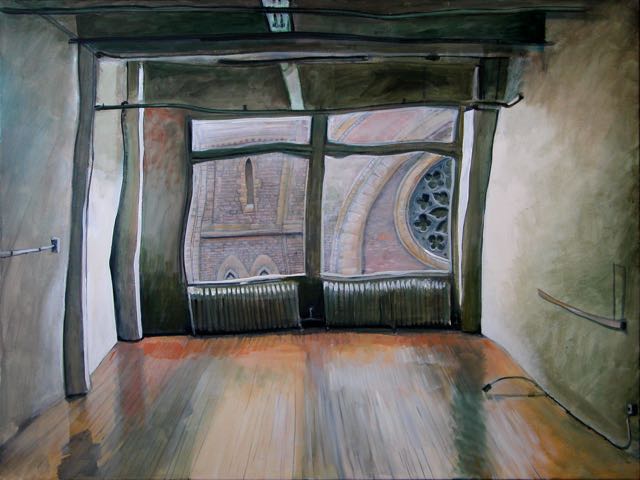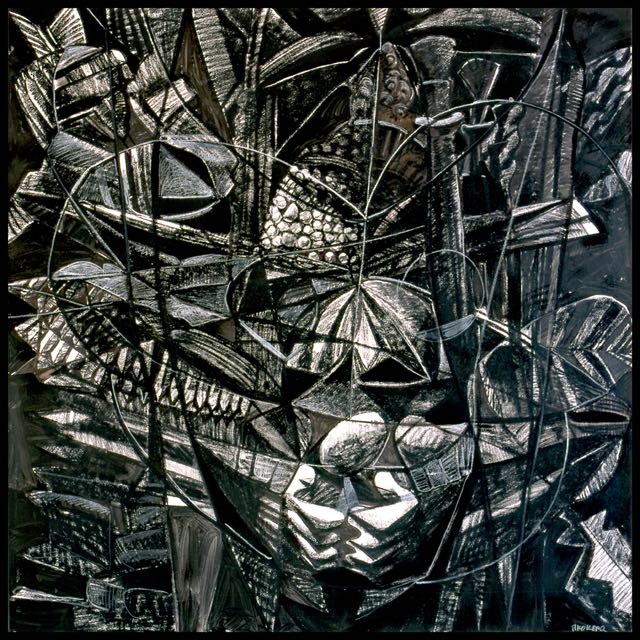
A VAGUE SUGGESTION OF RELIGION, acrylic on canvas, 36 x 48 inches, November 2005
An Essay by Jonathan Goodman - Critic, Writer
Tiko Kerr is a Vancouver-based painter who makes incisive paintings about his situation as a gay artist who has been HIV positive for more than twenty years; his paintings of hospitals and their uncanny artificial light and sterile furnishings give voice to a long relationship with medical treatment that has sometimes seemed nearly as troubling, and physically exhausting, as the presence of the virus itself. At the same time, he does not limit himself to paintings suggestive of his physical condition alone--he also offers idiosyncratic, visionary treatments of the city in which lives, as well as renderings of what might be called the spiritual legacy of First Nations peoples, which relate in a general way to the troubled, militarized circumstances of the world as it now exists. But beyond the topical reading of Kerr’s art is the issue of tradition--when Kerr was first starting out as an artist, he was mentored by the noted Canadian painter Jack Shadbolt. It is clear, then, that Kerr fits into the tradition of Canadian figurative painting, making a place for himself as part of a legacy that should be better known than it is outside of Canada.
Kerr points out in an artist’s statement that he is an “autodidact,” someone who has “worked very hard...developing my powers of visual analysis and a uniquely personal style of expression.” In the hospital paintings, the artist’s expressiveness is intensified by his medical condition; the interiors are slightly disturbing in their given light, which puts the contents of the room in a an alienating illumination, contrasting the cold, impersonal surroundings with the deeply felt awareness and vulnerability of the man reporting on them. These are not openly political paintings; however, their implications are social in the sense that Kerr has had the courage to confront his HIV status and the consequences of the disease. A recent painting, entitled Meditations on Compassion, gives a fish-eye view of the hospital scene he knows so well: the bed with its steel supports, the small sink in the corner, the inevitable television attached to the wall above the bed. The light in the painting is ghastly, bathing the furnishings of the room in ghostlike whites, creams, and greens; there is no suggestion that a patient is inhabiting the room. Indeed, the small space looks more like an invitation to the end of the world than anything else.
The hospital space in Meditations on Compassion challenges Kerr’s viewers to empathize with the harsh paraphernalia of his treatment; it is hard not to feel an overwhelming sympathy for the artist and his struggle to stay alive. But we are led to identify primarily because Kerr refuses to sentimentalize his circumstances; his hospital paintings become allegories denying the troubling impersonality of his care. There is no blame here; Kerr reports objectively, much as a doctor might, on what faces him. The room feels curiously alive, for Kerr has painted its windows and contours in gentle curves, accentuating both the strangeness of hospitals and his refusal to demonstrate any kind of self-indulgence, including pity. The Examination Room similarly documents the contents of a hospital room in garish light; as happens in Meditations, there is no human figure to openly claim our emotional response. Together the two paintings, with their slightly bent outlines and terrible illumination, act as catalysts for humane consideration.

THE SINS OF THE FATHER, conte, graphite and acrylic on canvas, 48 x 48 inches, March 2003
Living in Vancouver as he does, with First Nation culture in close proximity, Kerr inevitably has been drawn to portraying the vast presence of the totem poles that are part of his visual experience. Fish-Eater is a large painting describing a totem pole against a darkening blue sky; its symbolic masks are rendered in colors and whites, which highlight the raw power of indigenous spiritual expression. The totem, which is ours to see, suggests that it cannot be possessed; it is slightly intimidating in its otherness, in part because the conditions of its making are so different from our own art. It is impersonal in a very different way from the impersonality of Kerr’s hospital rooms, yet it too has been created as part of his imaginative, if not actual, heritage. Kerr continues his involvement with totemic imagery in the abstract work The Sins of the Father, which recreate bits and pieces of totemic patterning and melds them together so that they communicate a general feeling of otherness, perhaps disturbing as well. Done in blacks and whites, The Sins of the Father, with its geometric patterns and tribal markings, offers us a view entirely vivid within its own legacy and alignment. Its general feeling of unease may link it to the difficult world politics now facing us.
Kerr is an unusually gifted painter whose integrity and independence shines out with a real force of character. In an act of remarkable courage, he has made the events of his life public and asked that we experience them ever so slightly as his audience. At the same time, he has had the imaginative breadth of someone who is interested in documenting not only what is within him but also what is around him; his studies of nature and interiors are accomplished examples of his mind at work. And he has also kept alive the memory of a culture that is not his own by witnessing its extraordinary depth and form. He gives his viewers many aspects of his personality and curiosity, which yield powerful paintings that remain open to encounter. He is interested, as most good painters are, in life as it is being lived in contemporary times. This makes him an exemplar, an artist who communicates emotions that we cannot but feel as if they were our own. His imaginative interpretations of his life and thought remind us that we need not only to see the world, we must explore it as well.
Johnathan Goodman
Jonathan Goodman is a New York-based writer who has authored reviews and articles for such magazines as Art in America, Sculpture, and Art Asia Pacific. He has also written for Canadian publications such as Canadian Art, Parachute, and the Montreal Gazette. He is currently affiliated with Pratt Institute and the Parsons School of Design, both of which are in New York; he teaches courses on art criticism and contemporary art, as well as helping both undergraduate and graduate art students with the written theses that accompany their exhibitions.